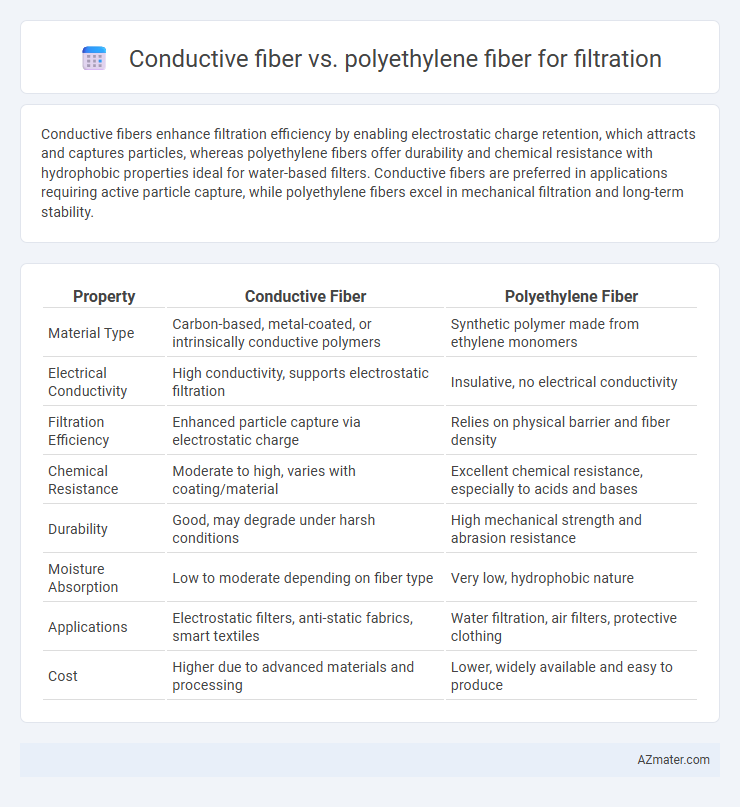Conductive fibers enhance filtration efficiency by enabling electrostatic charge retention, which attracts and captures particles, whereas polyethylene fibers offer durability and chemical resistance with hydrophobic properties ideal for water-based filters. Conductive fibers are preferred in applications requiring active particle capture, while polyethylene fibers excel in mechanical filtration and long-term stability.
Table of Comparison
| Property | Conductive Fiber | Polyethylene Fiber |
|---|---|---|
| Material Type | Carbon-based, metal-coated, or intrinsically conductive polymers | Synthetic polymer made from ethylene monomers |
| Electrical Conductivity | High conductivity, supports electrostatic filtration | Insulative, no electrical conductivity |
| Filtration Efficiency | Enhanced particle capture via electrostatic charge | Relies on physical barrier and fiber density |
| Chemical Resistance | Moderate to high, varies with coating/material | Excellent chemical resistance, especially to acids and bases |
| Durability | Good, may degrade under harsh conditions | High mechanical strength and abrasion resistance |
| Moisture Absorption | Low to moderate depending on fiber type | Very low, hydrophobic nature |
| Applications | Electrostatic filters, anti-static fabrics, smart textiles | Water filtration, air filters, protective clothing |
| Cost | Higher due to advanced materials and processing | Lower, widely available and easy to produce |
Introduction to Fiber Technologies in Filtration
Conductive fibers enable electrostatic filtration by dissipating static charges and enhancing particulate capture efficiency, making them ideal for applications requiring static control. Polyethylene fibers offer excellent chemical resistance and hydrophobicity, resulting in durable, moisture-repellent filter media suited for liquid and air filtration. Both fiber types contribute unique properties to advanced filtration technologies, optimizing performance based on specific environmental and operational demands.
Overview of Conductive Fiber Properties
Conductive fibers, typically made from carbon, metal-coated polymers, or intrinsically conductive polymers, offer excellent electrical conductivity essential for filtration applications requiring static dissipation or electromagnetic interference (EMI) shielding. These fibers exhibit high tensile strength, flexibility, and durability, enabling their integration into filters that can prevent particle buildup and enhance filtration efficiency through electrostatic attraction. Compared to polyethylene fibers, conductive fibers provide superior performance in environments demanding enhanced electrical properties and resistance to harsh chemical or thermal conditions.
Polyethylene Fiber: Structure and Characteristics
Polyethylene fiber features a highly crystalline structure with excellent hydrophobic properties, making it resistant to moisture and chemical degradation in filtration applications. Its low density and high tensile strength contribute to durability and efficiency in capturing particulates without clogging, enhancing airflow in filter media. The inert nature of polyethylene fibers ensures minimal interaction with contaminants, promoting longer filter lifespan and reducing maintenance requirements.
Filtration Efficiency: Conductive vs Polyethylene Fibers
Conductive fibers enhance filtration efficiency by creating electrostatic charges that attract and trap airborne particles, improving particle retention without increasing filter density. Polyethylene fibers offer good mechanical filtration but lack inherent electrostatic properties, resulting in lower particle capture efficiency compared to conductive fibers. Therefore, conductive fibers achieve superior filtration performance, especially for submicron particles, due to their combined mechanical and electrostatic filtration mechanisms.
Particle Capture Mechanisms
Conductive fiber filtration relies on electrostatic attraction to capture particles, enhancing efficiency for fine particulate matter compared to polyethylene fiber, which primarily utilizes mechanical interception, inertial impaction, and diffusion mechanisms. The charged surface of conductive fibers attracts oppositely charged particles, improving retention without significantly increasing airflow resistance. Polyethylene fibers, being hydrophobic and chemically inert, capture particles mainly through size exclusion and Brownian motion, making them effective for larger particulates but less efficient for ultrafine particles.
Durability and Lifespan in Filtration Applications
Conductive fibers exhibit superior durability compared to polyethylene fibers in filtration applications due to their enhanced resistance to mechanical stress and chemical degradation, maintaining filtration efficiency over extended periods. Polyethylene fibers, while cost-effective and lightweight, tend to degrade faster under high-temperature or harsh chemical environments, resulting in a shorter lifespan and reduced filtration performance. The longevity of conductive fibers supports sustained filtration quality and reduces maintenance frequency in industrial and environmental filtration systems.
Electrostatic Effects and Filter Performance
Conductive fibers enhance filtration efficiency by dissipating static charges, preventing particle agglomeration, and maintaining consistent airflow, which is crucial for capturing fine particulate matter. Polyethylene fibers generate electrostatic charges that attract and trap airborne particles, improving filter performance but may suffer from charge decay under high humidity conditions. The choice between conductive and polyethylene fibers depends on the filtration environment, with conductive fibers favored for stability and durability in electrostatic effects, while polyethylene fibers provide cost-effective initial filtration benefits.
Cost Analysis and Scalability
Conductive fibers generally incur higher costs due to advanced materials like carbon or metal coatings, which enhance filtration efficiency by enabling electrostatic capture mechanisms. Polyethylene fibers offer a cost-effective alternative with scalable production, benefiting from established polymer processing techniques and lower raw material expenses. Scalability favors polyethylene fibers in large-scale industrial filtration applications, while conductive fibers remain preferred in niche markets demanding high-performance filtration with integrated antimicrobial or sensor capabilities.
Environmental Impact and Sustainability
Conductive fibers, such as carbon-infused or metal-coated materials, offer enhanced filtration efficiency but often involve energy-intensive production and challenges in recyclability, raising concerns about environmental impact. Polyethylene fibers, commonly used in filtration due to their chemical resistance and durability, are derived from petrochemicals, contributing to plastic pollution and limited biodegradability. Sustainable filtration solutions prioritize biodegradable or recyclable materials, highlighting the need for innovations in conductive fiber recycling and the development of bio-based polyethylene alternatives to reduce ecological footprints.
Choosing the Right Fiber: Application-Based Recommendations
Conductive fibers excel in filtration applications requiring electrostatic charge dissipation and particle attraction, making them ideal for air filters in electronics and cleanrooms. Polyethylene fibers offer superior chemical resistance and hydrophobic properties, suited for liquid filtration and harsh chemical environments. Selecting the right fiber depends on specific filtration needs such as electrostatic conductivity, chemical resistance, and environmental conditions.

Infographic: Conductive fiber vs Polyethylene fiber for Filtration
 azmater.com
azmater.com